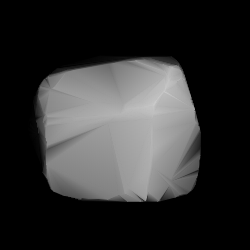
124 Alkeste is a main-belt asteroid, and it is an S-type (silicaceous) in composition. C.H.F. Peters discovered the asteroid on August 23, 1872, from the observatory at Hamilton College, New York State. The name was chosen by Adelinde Weiss, wife of the astronomer Edmund Weiss, and refers to Alcestis, a woman in Greek mythology.
151 Abundantia is a stony main belt asteroid. It was discovered by Johann Palisa on 1 November 1875, from the Austrian Naval Observatory in Pula. The name was chosen by Edmund Weiss of the Vienna Observatory; although the name refers to Abundantia, a Roman goddess of luck, it was also chosen to celebrate the increasing numbers of asteroids that were being discovered in the 1870s.

229 Adelinda is a large, dark outer main-belt asteroid. It was discovered by Austrian astronomer Johann Palisa on August 22, 1882, in Vienna, and was named after Adelinda, the wife of fellow Austrian astronomer Edmund Weiss.

261 Prymno is a somewhat large Main belt asteroid. It is classified as a B-type asteroid and probably has a primitive composition not unlike common C-type carbonaceous asteroids.

264 Libussa is a Main belt asteroid that was discovered by C. H. F. Peters on December 22, 1886, in Clinton, New York and was named after Libussa, the legendary founder of Prague. It is classified as an S-type asteroid.

267 Tirza is a fairly sizeable, very dark Main belt asteroid.
479 Caprera is a minor planet orbiting the Sun.

486 Cremona is a minor planet orbiting the Sun.
494 Virtus is an 86 km minor planet orbiting the Sun. It was discovered by Max Wolf on October 7, 1902. Its provisional name was 1902 JV.
500 Selinur is a minor planet, specifically an asteroid orbiting in the asteroid belt. Like 501 Urhixidur and 502 Sigune, it is named after a character in Friedrich Theodor Vischer's then-bestseller satirical novel Auch Einer.
507 Laodica is a minor planet orbiting the Sun.
521 Brixia is a relatively large minor planet, specifically an asteroid orbiting mostly in the asteroid belt that was discovered by American astronomer Raymond Smith Dugan on January 10, 1904. The name derives from Brixia, the ancient name of the Italian city of Brescia.
586 Thekla is a minor planet orbiting the Sun. It was named after Saint Thecla of the first century. The name may have been inspired by the asteroid's provisional designation 1906 TC.
633 Zelima is a minor planet orbiting the Sun in the asteroid belt with a magnitude of 10.7. The name may have been inspired by the asteroid's provisional designation 1907 ZM.
635 Vundtia is a minor planet orbiting the Sun - though this claim has been disputed.

643 Scheherezade is a minor planet orbiting the Sun. It was named after the fictional storyteller Sheherazad.
663 Gerlinde is a minor planet orbiting the Sun.
696 Leonora is a Meliboean asteroid orbiting the Sun in the asteroid belt. It was discovered 10 January 1910 by American astronomer Joel Hastings Metcalf, at Taunton, Massachusetts. It was named by Arthur Snow of the United States Naval Observatory, who computed the orbit for the planet, after his wife, Mary Leonora Snow.
860 Ursina is a minor planet orbiting the Sun that was discovered in 1917 by German astronomer Max Wolf. The origin of the name is unknown.

875 Nymphe is a minor planet orbiting the Sun. It is a member of the Maria family of asteroids.








